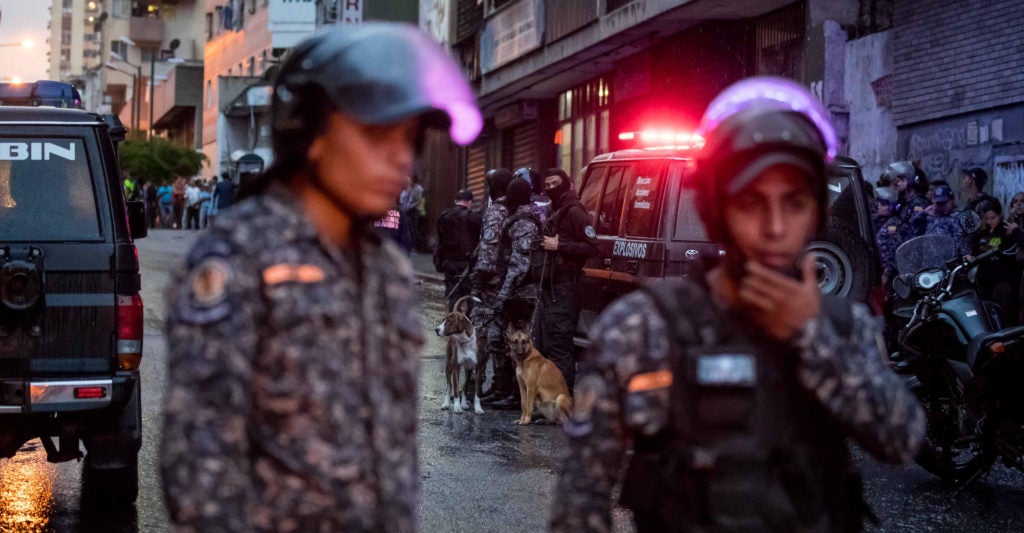Venezuelan President Nicolás Maduro was the target Saturday of an alleged assassination attempt carried out by two drones.
If this was indeed a drone attack on a head of state, it is a wake-up call for policymakers and law enforcement officials everywhere.
According to reports, two explosives-laden drones of a type commercially available and commonly used for aerial filmmaking detonated during the dictator’s remarks at a National Guard ceremony in Caracas, Venezuela. Maduro was not harmed.
One video purports to show one of the drones detonating in midair; the other drone evidently crashed into an apartment building several blocks away and exploded. Seven soldiers reportedly were injured.
It is difficult to judge the accuracy of these accounts, and Maduro’s authoritarian regime hardly deserves the benefit of the doubt—particularly regarding an incident that can be used to justify his further consolidation of power.
But again, this could be a wake-up call. The Islamic State and other terror groups have weaponized commercially available drones in Iraq and Syria, and officials long have warned that it is only a matter of time before those dangers migrate from the battlefield to domestic skies.
It seems that day may have arrived, which means it is past time to finally empower U.S. law enforcement agencies to protect the public from this new airborne threat.
Drones are proliferating around the world, driven mainly by interest in their commercial and recreational potential.
But it is becoming increasingly clear that entrepreneurs and hobbyists are not the only ones to recognize the utility of small drones. International drug cartels are using “narco-drones” to ferry drugs over the heads of Border Patrol agents who are largely powerless to stop them.
Other criminal organizations are using drones to surveil and disrupt law enforcement operations. Criminals are developing their own rudimentary package delivery operations, dropping contraband like weapons and drugs behind prison walls. In Ohio, one of these drops incited a 75-inmate brawl.
Drones also increasingly are sighted in restricted airspace. Pilots report them with increasing frequency near major airports.
Earlier this year, an Army Black Hawk helicopter collided with a drone in New York. In the past week, a near-collision with a helicopter fighting a wildfire in Idaho forced the grounding of all firefighting aircraft.
Drones have been used to drop leaflets on crowds at football stadiums, and in 2015, one penetrated restricted airspace around the White House and crashed on the lawn.
These incidents reveal two things: High-value targets, such as mass gatherings and critical infrastructure—even hardened targets such as the executive mansion—are exposed and vulnerable to hostile or reckless drones, and U.S. law enforcement agencies are ill-equipped to address these threats.
The alleged attack in Venezuela puts the potential consequences of this dynamic in stark relief.
U.S. law enforcement agencies need counter-drone tools to detect, track, and identify drones that pose a danger to the public and to offer countermeasures to interdict them in the manner least likely to result in collateral damage.
Private-sector companies already are developing and testing a range of counter-drone technologies, from hacking and jamming tools to lasers and projectile weapons, to shoot them down.
But as it stands, few counter-drone solutions can be employed because multiple federal laws make drone interdiction illegal. One law criminalizes damaging or destroying an “aircraft,” and unbelievably, the Federal Aviation Administration has asserted that this law—written to deter shooting down manned aircraft—applies to drones, meaning they cannot be damaged.
Other statutes and regulations prohibit hacking and jamming tools, which some law enforcement agencies have sought to obtain in the event of a drone threat.
In July, Homeland Security Secretary Kirstjen Nielsen wrote that, because of these legal restrictions, federal law enforcement agencies “are prevented from even testing certain drone-defense technologies,” and that the “threat is outpacing our ability to respond.”
Fortunately, legislation has been introduced in both the House and Senate to begin to rectify this. This effort, led by Sen. Ron Johnson, R-Wis., and Rep. Mike McCaul, R-Texas, would provide legal authority to the departments of Justice and Homeland Security to mitigate drone threats.
Under that legislation, both agencies would be empowered to protect certain assets and critical facilities and to advance specific law enforcement missions. They would do so by acquiring and using counter-drone technology to “detect, identify, monitor and track” drones and to seize or destroy them if they are determined to be a threat.
The bills require development of procedures to govern the use of these technologies and broad coordination among federal agencies, including with the Department of Transportation and the Federal Aviation Administration. They also establish provisions to protect the privacy and Fourth Amendment rights of Americans.
These are proper steps, but they will be inadequate unless we work to bring in state and local officers, as well. In the vast majority of criminal and terrorist incidents, the first people on the scene are local police.
Ensuring federal agents have the means and authorization to engage hostile drones is essential, but that will be small comfort to an NYPD officer confronting a bomb-laden drone with only a radio, flashlight, firearm, and the hope his actions won’t land him in front of a judge.
That is why scholars at The Heritage Foundation have proposed deputizing state and local officers as part of a counter-drone pilot program that would allow them to test and train on this equipment under the supervision of federal officials.
That approach could shave years off the roll-out of these defensive technologies, build core competencies in departments across the nation, and leave Americans better situated to deal with the drone threat.
As the weekend’s drone incident showed, the threat of drone attacks is not going anywhere, and it will only get worse.
